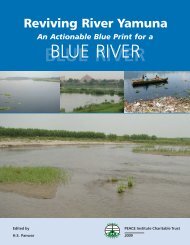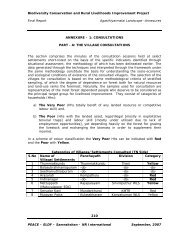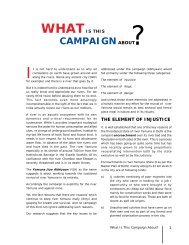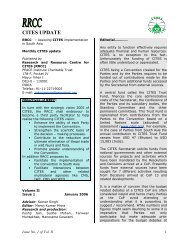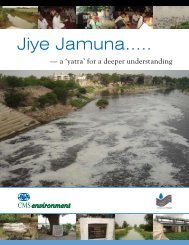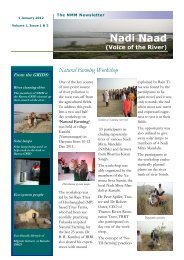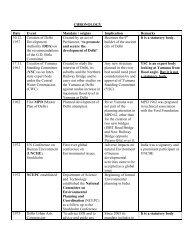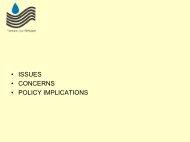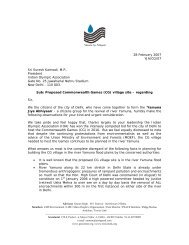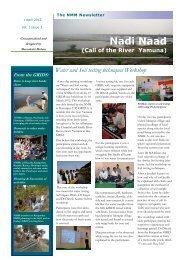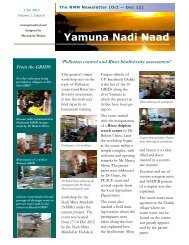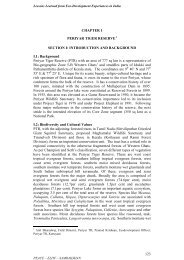Jiye Jamuna..... - PEACE Institute Charitable Trust
Jiye Jamuna..... - PEACE Institute Charitable Trust
Jiye Jamuna..... - PEACE Institute Charitable Trust
You also want an ePaper? Increase the reach of your titles
YUMPU automatically turns print PDFs into web optimized ePapers that Google loves.
<strong>Jiye</strong> <strong>Jamuna</strong>.....<br />
- a ‘yatra’ for a deeper understanding<br />
1
Disclaimer: The speakers of the summit are responsible for the choice and the presentation of the facts contained in this report and for the<br />
opinions expressed therein, which are not necessarily those of CMS and do not commit the organization. Although every precaution has<br />
been taken in compiling the speaker’s presentation and deliberations, CMS assumes no responsibility for errors or omissions, which might<br />
have crept in due to third party information. Neither is there any liability assumed for damage resulting from use of such information. The<br />
publication may be used in any form. Please feel free to quote and distribute with due acknowledgment.<br />
Edition First<br />
© xxxxxxxx<br />
For additional copies and further information, please contact:<br />
xxxxxxxx<br />
xxxxxxx<br />
xxxxxxxxxxx<br />
P: xxxxxxxxxxxxxx<br />
F: xxxxxxxxxxxxxxxxxxx<br />
E: xxxxxxxxxxxxxxxxxxxx<br />
www.xxxxxxxxxxxxxx<br />
Cover photo: xxxxxxxxxxxxxxx<br />
Design: xxxxxxxxxxxxxxxxx<br />
2
Content<br />
3
Profound Learning<br />
From A Child<br />
A fellow yatri recounted at one of our daily briefing sessions<br />
during the recent Yamuna Yatra:<br />
“Beta nadi kya karti hei, (son, what does a river do?) we had<br />
asked of a group of giggling yet curious children, at one of<br />
our road side gatherings. One of them after some amount<br />
of persuasion had quipped much to our wonder, nadi behti<br />
hei……. (river flows)”<br />
YES. Nadi behti hei…. Could there be a better understanding<br />
of a river?<br />
It is only a still ‘unpolluted’ discerning mind of a child that<br />
would retain this unique feature of a river. And yet herein lie<br />
the deepest TRUTH of a river!<br />
If there is one single attribute that distinguishes a river from<br />
any other natural system on earth then it is its ability to<br />
flow from origin till confluence. No other ecological system<br />
does this in the said manner. It is this unique attribute of the<br />
river which results in a sphere of influence called the riparian<br />
zone extending on either bank and carrying distinctive soil<br />
conditions and the resulting unique flora and fauna there in.<br />
Again perhaps it is this single attribute of a river which<br />
would have attracted pre historic humans to it leading to the<br />
flourishing of all the ‘great’ river valley human civilizations of<br />
the past as it was the river which was the ready source of<br />
ever renewing fresh water to them, meeting their drinking,<br />
bathing, cleaning, fishing, and transportation needs. No<br />
wonder the rivers came to occupy a role akin to a mother<br />
(maiyya) to them.<br />
In other words if a river is inhibited from its free flow then<br />
it would be like a forceful change in its nature and in turn its<br />
demise as a natural system. Dams, barrages, embankments,<br />
pseudo bridges etc. on rivers with admittedly their own<br />
purpose to serve for the mankind who created them, are<br />
artificial structures that inhibit the free flow of a river. Let us<br />
take the example of Delhi.<br />
Delhi owes its existence to river Yamuna. It had only one<br />
rail cum road bridge over the river till about 1958. The<br />
river water till then was abundant, crystal clear and a joy<br />
to behold and consume. Delhites were then one with their<br />
life-line river.<br />
A serious jaundice outbreak (claiming around 300 lives) in<br />
the city led to the formation of the Wazirabad Barrage over<br />
the river with the objective to separate the city’s drinking<br />
water supplies met from the river away from the polluted/<br />
infected waters of the Najafgarh drain which had presumably<br />
infected the river and caused the jaundice outbreak. It would<br />
soon prove to be a misplaced solution much worse than<br />
the disease, since the wrong ‘culprit’ had been caught and<br />
harnessed. In all fairness it should have been the Najafgarh<br />
drain which should have been taken care of in the best<br />
possible manner so that it did not infect the river waters<br />
again, rather than barraging the river and obstructing its<br />
natural flow.<br />
Soon enough the river downstream of the Wazirabad<br />
Barrage started to lose all its glory so much so that by the<br />
late seventies it had turned into no more than sewage drain<br />
for almost nine months of the year.<br />
The city being the capital of the country attracted people<br />
from far and wide and soon turned itself into a megapolis.<br />
But the river lost not only its pride of place in the city’s<br />
life but faded away even from the public memory. Newer<br />
bridges (pseudo ones) and more barrages (to meet industrial<br />
and irrigation needs) came to be built at two more sites<br />
(ITO and Okhla) on the river. More and more drains started<br />
to bring sewage and muck of the city into the river and its<br />
banks. The river had for all practical purposes ceased to<br />
remain one. All this happened as if the river was meant just<br />
to meet Delhi’s domestic and industrial water needs and to<br />
take away its refuse as its underbelly.<br />
No wonder we heard repeatedly from the local people<br />
during the Yatra that it is YOU, people of Delhi, who are to<br />
blame for all the ills that the river is facing today.<br />
4
But what could have been otherwise and is that possible even<br />
now?<br />
Delhi would need to ensure that it remedies the situation<br />
and let the river be. To do so both the Wazirabad barrage<br />
and the Okhla barrage would need to be decommissioned<br />
as a barrage. And the river allowed a free flow within the<br />
NCTD.<br />
Fortunately we still have the above option available to us.<br />
Create an interceptor drain under / alongside the outer ring<br />
road or the Mathura Road from Wazirabad till where it meets<br />
the Agra canal and allow the sewage of Delhi which is today<br />
entering the river, via at least twenty drains starting with<br />
the Najafgarh drain, to get directly through the interceptor<br />
drain into the Agra Canal and away from the river proper.<br />
This would substitute for the role today being played by<br />
the Okhla barrage. Now decommission the Okhla barrage<br />
as being unnecessary. Expensive STPs in the city would<br />
then not even be needed since raw sewage (after filtering<br />
for solid wastes like plastic and ensuring that no untreated<br />
industrial waste has contaminated it) would be fine to meet<br />
the irrigation requirements of downstream Haryana and UP,<br />
the purpose for which the Okhla barrage was created.<br />
Now once the Najafgarh drain (including its tributaries) and<br />
all the other polluting drains falling into the river from the<br />
west of the river have been taken care of then the Wazirabad<br />
barrage can safely be decommissioned with only the bridge<br />
over it staying.<br />
Let the Wazirabad water treatment plant (WTP) then<br />
continue to access secure (without any infection threat) free<br />
flowing river water for meeting the water needs of the city<br />
as it used to do before the Wazirabad barrage was unwisely<br />
created.<br />
In this manner Delhi can show the way forward (in form of<br />
interceptor mechanisms that prevent the city’s sewage to<br />
fall into the river) for the revival of their rivers to the rest of<br />
the country and to the other riparian states of river Yamuna.<br />
But for the scenario as visualized above to become a reality<br />
the river would still require uninterrupted flow of water<br />
downstream of the Hathnikund barrage, 250 km upstream<br />
of Delhi, where the river currently loses major portion of its<br />
non monsoonal water flow to the Western and the Eastern<br />
Yamuna canals. But that’s another, although perfectly doable<br />
story.<br />
Let Delhi, as the nation’s capital city-state lead the way<br />
first.<br />
Manoj Misra<br />
Convenor, Yamuna <strong>Jiye</strong> Abhiyaan<br />
5
Acknowledgement<br />
The nine day Yamuna Satyagrah Yatra – <strong>Jiye</strong> <strong>Jamuna</strong>, <strong>Jiye</strong> Jana,<br />
Jana, from 5 – 13 June 2008 over some 300 km from Delhi<br />
to Agra and back along the river would not have happened but<br />
for the following agencies and individuals, whose facilitation and<br />
assistance is gratefully acknowledged:<br />
Agencies<br />
1. Indian National <strong>Trust</strong> for Art and Cultural Heritage (INTACH),<br />
Delhi<br />
2. WWF India, Delhi<br />
3. Centre For Media Studies (CMS), Delhi<br />
4. Environics <strong>Trust</strong>, Delhi<br />
5. Winrock International-India, Gurgaon<br />
6. Tarun Bharat Sangh / Jal Biradari, Jaipur<br />
7. Youth For Justice, Delhi<br />
Individuals<br />
1. All the participating Yatris<br />
2. Sri S. K. Misra<br />
3. Sri Samar Singh<br />
4. Sri Ravi Singh<br />
5. Dr N. Bhaskar Rao<br />
6. Dr R. Sreedhar<br />
7. Sri Rajendra Singh<br />
8. Sri Sanjay Parikh<br />
9. Dr Parikshit Gautam<br />
10. Ms Alka Tomar<br />
11. Sri Abhinandan Sekhri<br />
12. Sri B. M. S. Rathore<br />
13. Captain Alok Bahuguna<br />
14. Mrs Shashi Bahuguna<br />
15. Dr Shanti Prasad Pokhriyal<br />
16. Sri Kishan Chaturvedi<br />
17. Sri Gopeshwar Nath Chaturvedi<br />
18. Sri Srivats Goswami<br />
19. Sri Raman ji<br />
20. Sri Ashwani Kumar Mishra<br />
21. Sri Ravi ji<br />
Last but not the least we have no words to thank all our gracious<br />
hosts at various places where we halted for the night and the<br />
countless number of villagers who shared with us their wisdom,<br />
understanding and enthusiasm for the cause of the revival of the<br />
river.<br />
Caveat<br />
The water quality report and information is based on one time<br />
testing only. Therefore these figures may not be quoted or assumed<br />
as definitive. These are meant only to highlight and appreciate a<br />
change in water quality as we progressed along the Yatra.<br />
6
Background<br />
Qutub se Taj, Ek hi Awaj – <strong>Jiye</strong> <strong>Jamuna</strong>, <strong>Jiye</strong> Jana, Jana<br />
The Yamuna<br />
Arising from the Yamunotri, river Yamuna flows through a<br />
series of valleys for about 200 Kms, in lower Himalayas and<br />
emerges into Indo-Gangetic plains. Flowing through Poanta<br />
Sahib it reaches Hathnikund/Tajewala in Yamuna Nagar<br />
district of Haryana state, where the river water is diverted<br />
into Western Yamuna canal and Eastern Yamuna canal for<br />
irrigation. During dry season, no water is allowed to flow<br />
in the river downstream to Tajewala barrage and the river<br />
remains dry in some stretches between Tajewala and Delhi.<br />
The river regains water because of ground water accrual and<br />
contributions of feeding canal through Som nadi (seasonal<br />
stream) upstream of Kalanaur. It enters Delhi near Palla<br />
village after traversing a meandering path of about 396 km.<br />
The river is again tapped at Wazirabad through a barrage<br />
for drinking water supply to Delhi. Generally, water flow is<br />
negligible downstream of Wazirabad barrage in dry season.<br />
Water flow in the downstream of Wazirabad barrage is<br />
the untreated or partially treated domestic and industrial<br />
wastewater contributed through several drains along with<br />
water transported by Haryana Irrigation Department from<br />
Western Yamuna Canal (WYC) via Nazafgarh Drain. After<br />
22 Km downstream of Wazirabad barrage, is the Okhla<br />
barrage through which Yamuna water is diverted into Agra<br />
Canal for irrigation. No water flows through the barrage<br />
during dry season. Whatever water flows in the river<br />
beyond Okhla barrage is contributed through domestic and<br />
industrial wastewater generated from East Delhi, Noida<br />
and Sahibabad and joins the river through Shahdara drain.<br />
The Yamuna after receiving water through other important<br />
tributaries joins River Ganga and the mythical / underground<br />
Saraswati at Prayag (Allahabad) after traversing about 1370<br />
Km. Thus, Yamuna river cannot be designated as continuous<br />
river particularly in dry season (almost 9 months).<br />
The catchment of Yamuna river system covers parts of Uttar<br />
Pradesh, Uttranchal, Himachal Pradesh, Haryana, Rajasthan,<br />
Madhya Pradesh & Delhi states.<br />
Name of<br />
State<br />
The catchment of River Yamuna<br />
Total Catchment<br />
Area in Yamuna<br />
(in Sq. Km.)<br />
%age<br />
contribution<br />
Uttar Pradesh 74208 21.5<br />
(including Uttranchal)<br />
Himachal Pradesh 5799 1.6<br />
Haryana 21265 6.5<br />
Rajasthan 102883 29.8<br />
Madhya Pradesh 14028 40.6<br />
Delhi 1485 0.4<br />
Distinct Segments of River Yamuna<br />
Himalayan Segment From origin to Tajewala Barrage (172 kms)<br />
Upper Segment Tajewala Barrage to Wazirabad Barrage (224 kms)<br />
Delhi Segment Wazirabad Barrage to Okhla Barrage (22 kms)<br />
Eutriphicated Segment Okhla Barrage to Chambal Confluence (490 kms)<br />
Diluted Segment Chambal Confluence to Ganga Confluence (468 kms)<br />
7
Background to the Yatra<br />
It is known that the state of the river Yamuna is at its most<br />
stressed and threatened in its Delhi to Agra stretch of<br />
around 250 km. It is also the stretch where the river is at its<br />
holiest due to its association with the leelas of Lord Krishna<br />
in a region now popularly called the Braj Bhoomi.<br />
So, if one were to understand the river and its people to<br />
seek solutions if any for the long term revival of the river<br />
then a closer look at the river in this stretch would be an<br />
obvious starting point.<br />
Accordingly, the ongoing Yamuna Satyagrah at Delhi<br />
decided to embark upon the river Yamuna discovery yatra<br />
on mobikes along side the river over a period which may<br />
be neither too hurried nor too leisurely with the following<br />
broad objectives:<br />
a) Avalokan (Close view of the river)<br />
b) Sampark (Interaction with local people and<br />
organisations)<br />
c) Samajh (Understanding and documentation of the river<br />
based on ‘a’ and ‘b’ above)<br />
Yatra Program<br />
a) The Yatra was held from 5 June 2008 (World<br />
Environment Day) till 13 June 2008.<br />
b) The period of the Yatra was on purpose chosen to be<br />
early June as the river would then be in its most stressed<br />
state and hence provide a good baseline.<br />
c) The key purpose of the Yatra was to travel as close<br />
to the river as possible to seek, learn and establish<br />
a baseline on the river Yamuna in terms of its water<br />
quality, flood plain status, people’s relations with the<br />
river, groups already working for the river Yamuna,<br />
etc.<br />
d) There were 20 full time Volunteers (on bikes) and two<br />
support vehicles<br />
e) Each participant was voluntarily made part of a sub<br />
group tasked with a specific assignment in tune with the<br />
Yatra’s purpose<br />
f) A recce visit along the route made in advance by youth<br />
for Justice, on two different days identified the following<br />
as the places of visit / halt during the Yatra:<br />
Date of Halt<br />
Place<br />
5.6.08 Tigaon<br />
6.6.08 Bodoli<br />
7.6.08 Kosi<br />
8.6.08 Vrindavan<br />
9.6.08 Farah<br />
10.6.08 Agra<br />
11.6.08 Agra<br />
12.6.08 Farah<br />
13.6.08 Mathura – Raya – Mant – Surir –<br />
Naujhil – Chata - Delhi<br />
A two member team from the Environics <strong>Trust</strong> joined the<br />
yatra, carrying an in house developed field kit ‘DOST’ and<br />
took 46 samples of river water, drinking water in the flood<br />
plains, waste water from industries and domestic areas and<br />
canal water at different points along the yatra route.<br />
8
The Yatra Route<br />
9
10<br />
Day 1 (5 June 2008)
DELHI<br />
(Satyagrah Sthal)<br />
A briefing and formal registration (sample enclosed)<br />
of 23 volunteers (which included local farmers, youth,<br />
environmentalists and water activists, members of the<br />
ongoing Yamuna Satyagrah, active journalists, photographers,<br />
scientists and individual enthusiasts) was held since early<br />
morning at the Yamuna Satyagrah Sthal, alongside the NH<br />
24, behind the Akshardham.<br />
Okhla Barrage (Delhi)<br />
Halting first on the Delhi side of the Okhla Barrage for<br />
testing (by the expert team) of the water flowing in the<br />
Agra Canal (originating from the river Yamuna at the<br />
Okhla Barrage) and to await the arrival of Ravleen, whose<br />
bike had already suffered the second puncture of the day<br />
the Yatra progressed along the river on the right marginal<br />
embankment (RME) that led us to the village Jaitpur (the last<br />
village of Delhi on the river bank).<br />
Subsequently the Yamuna Satyagrah Yatra - 2008 started<br />
with singing of bhajans, ragani (folk song) and the Yamuna<br />
aarti led by the indefatigable Kishori Bhai (a local farmer who<br />
has turned poet, composer and singer during the Yamuna<br />
Satyagrah). In all 28 excited (young and not so young)<br />
persons in 10 two wheelers and 2 support four wheel<br />
vehicles embarked on the Yatra.<br />
Water quality testing of Agra Canal (as it leaves the Okhla<br />
Barrage) in progress under the expert guidance of Dr Shanti<br />
Prasad Pokhriyal (Environics <strong>Trust</strong>).<br />
Findings on some key parameters<br />
Location<br />
Temperature<br />
Agra Canal (Okhla Barrage) Delhi<br />
29 deg C<br />
pH 8.2<br />
Color<br />
Odour<br />
DO<br />
Nitrogen<br />
TDS<br />
Dark<br />
Foul<br />
Absent<br />
23 mg/lt<br />
892 mg / lt<br />
Source: Environics <strong>Trust</strong>, New Delhi<br />
11
The river as it leaves the Okhla Barrage<br />
Jaitpur Village (Delhi)<br />
On the other side of the river (the UP side) construction of<br />
several high rises in the river bed presented a sore sight.<br />
The slow but steady encroachment into the river bed<br />
(beyond the RME) in the name of Jaitpur Ext. could be easily<br />
observed.<br />
12
Lunch in Jaitpur at the Gurmit Punjabi Dhaba was a rather<br />
hurried cum harried affair and provided an indication of the<br />
rough and tough conditions that lay ahead in store for the<br />
Yatris.<br />
Further we crossed the Ali nalla running towards the river<br />
along side the Jaitpur village.<br />
An irrigation channel as it leaves the Agra Canal<br />
Location<br />
Temperature<br />
Irrigation Canal emerging out of Agra<br />
Canal post Jaitpur village<br />
27 deg C<br />
pH 8.5<br />
As we reached the Agra Canal once again with the backdrop<br />
of Badarpur Power Plant, the despoliation of water by such<br />
‘developmental activity’ was more than evident.<br />
Color<br />
Odour<br />
DO<br />
Nitrogen<br />
TDS<br />
Dark<br />
Foul<br />
0.242 mg / lt<br />
33 mg/lt<br />
235 mg / lt<br />
Source: Environics <strong>Trust</strong>, New Delhi<br />
Badshahpur<br />
13
A visit to a 20 mld STP (Sewage Treatment Plant) raised<br />
under YAP (Yamuna Action Plan) phase I in the village<br />
Badshahpur to cater to the sewage load of Faridabad town<br />
was a revelation of sorts. Firstly it was found shut. Reasons<br />
being its upgradation that was underway for capacity<br />
enhancement. An insider story revealed that even when<br />
operational it hardly meets the requirement as industrial<br />
waste is often surreptitiously mixed into the sewage lines<br />
and then the role of the STP is left only to sieve the sewage<br />
of the solid particles like the polythene. The fact that there<br />
is hardly any treatment that takes place in the STP was also<br />
realised since it is more sieving and sedimentation that is<br />
actually taking place in an STP than any treatment of sewage<br />
water per se.<br />
Attractive traditional art work on dung cake (upale) heaps could be seen along side the roads.<br />
14
Dadasiya Village<br />
Interaction and ragani session at the Rajpurkala village<br />
Location<br />
Temperature<br />
Handpump water at Rajpur Kalan<br />
25 deg C<br />
pH 7.6<br />
River at Dadasiya village – almost a trickle<br />
Color<br />
Odour<br />
DO<br />
Nitrogen<br />
Transparent<br />
Agreeable<br />
Absent (NA)<br />
NA<br />
Location<br />
Temperature<br />
River water at Dadasiya<br />
28 deg C<br />
pH 7.9<br />
Color<br />
Dark<br />
TDS<br />
25 mg / lt<br />
Source: Environics <strong>Trust</strong>, New Delhi<br />
It was dark by the time we reached the Shiv Mandir at Tigaon,<br />
where we were scheduled to halt for the night.<br />
Odour<br />
DO<br />
Nitrogen<br />
TDS<br />
Foul<br />
0.862 mg / lt<br />
53 mg/lt<br />
144 mg / lt<br />
Source: Environics <strong>Trust</strong>, New Delhi<br />
Rajpur Kalan<br />
From Dadasia we raced to Rajpurkalan village where the<br />
villagers had been awaiting our arrival. A round of ragani<br />
followed by hearty refreshment by our hosts (relatives of<br />
Masterji) rounded the day for us.<br />
15
16<br />
Day 2 (6.6.2008)
TIGAON<br />
The day began early for the Yatris as no one could sleep<br />
overnight. A heavy downpour followed by power breakdown<br />
had ensured that the mosquitoes had a field day (night) and<br />
the Yatris an unsleepable night. But no one was complaining,<br />
yet.<br />
Location<br />
Temperature<br />
Hand pump Shiv Temple, Tigaon<br />
25 deg C<br />
pH 7.6<br />
Color<br />
Transparent<br />
Odour<br />
Agreeable<br />
DO<br />
Nitrogen<br />
TDS<br />
Absent (NA)<br />
28 mg/lt<br />
124 mg / lt<br />
Source: Environics <strong>Trust</strong>, New Delhi<br />
MAJHAWALI<br />
The sad state of local water bodies (Johads) as villages ‘develop’<br />
into towns.<br />
Signs of ‘development’ along side the river at the Majhawali<br />
village.<br />
Location<br />
Temperature<br />
Temperature<br />
Johar (water body) at Tigaon<br />
28 deg C<br />
31 deg C<br />
pH 7.2<br />
Color<br />
Odour<br />
DO<br />
Dark<br />
Foul<br />
1.250 mg / lt<br />
Nitrogen -<br />
TDS<br />
1164 mg / lt<br />
Source: Environics <strong>Trust</strong>, New Delhi<br />
The river has augmented water supplies courtesy the Budhiya<br />
nala that meets the river upstream of Majhawali village.<br />
17
Location<br />
Temperature<br />
Majhawali village hand pump<br />
26 deg C<br />
pH 7.5<br />
Color<br />
Odour<br />
DO<br />
Transparent<br />
Agreeable<br />
Absent (NA)<br />
Nitrogen -<br />
TDS<br />
12.8 mg / lt<br />
Source: Environics <strong>Trust</strong>, New Delhi<br />
Water is sweet and potable.<br />
Budhiya Nala a tributary of river Yamuna under developmental<br />
pressure of private interests (SRS is building a road cum bridge<br />
over it to reach to its planned golf course coming up across the<br />
Nala) in village Amirpur, Greater NOIDA high rises (on UP side)<br />
can be seen in the background.<br />
The sinister footprints of industrialisation were narrated to<br />
us by the village folks of Majhawali whence the effluents from<br />
a textile establishment in the area had so polluted the lands<br />
that their wheat crops had wilted and it was only a massive<br />
demonstration by the affected farmers that somewhat<br />
remedied the situation.<br />
CHAENSA VILLAGE<br />
Yatris conversing with Sri Ram Chandra, father of the lady<br />
Sarpanch of village Majhawali.<br />
Our first halt for the day was Majhawali village, where the<br />
village elderman Sri Ram Chandra, the father of the lady<br />
Sarpanch, warmly welcomed the spirit and the message of<br />
the Yatra. We were informed that the village area had been<br />
declared an institutional area by the government and hence a<br />
number of technical institutions had either already come up<br />
or were currently in the process. Soon the rural skyline was<br />
destined to a changeover into an urban / semi urban one.<br />
We were also witness to the manner in which the Bhudiya<br />
nala (feeding the river) was being embanked by a private<br />
company (SRS Constructions) to build a road that would<br />
open an island surrounded by the river and the nala into a<br />
real estate haven. Emerging Greater NOIDA skyline (on UP<br />
side of the river) was easily seen on the other side of the<br />
river from here.<br />
River Yamuna at Chhaensa (River Hindon has augmented water<br />
supply to it after confluence)<br />
18
A refreshing round of bhajans and ragani led by in imitable Kishori<br />
Bhai at the Chaensa village<br />
VILLAGE CHANT<br />
Location<br />
Temperature<br />
River Yamuna, Chaensa<br />
29 deg C<br />
Ph 7.8<br />
Color<br />
Odour<br />
DO<br />
Nitrogen<br />
TDS<br />
Dark<br />
Partially agreeable<br />
6.5 mg / lt<br />
48 mg/lt<br />
446 mg / lt<br />
Source: Environics <strong>Trust</strong>, New Delhi<br />
19
After a rather intense interaction at the Village Assembly in<br />
village Chant where a local teacher chided the villagers on<br />
“how could they talk of cleaning the river when they keep their<br />
village in such an unhygienic condition”, a round of raganis<br />
exchanged between Kishori, Mahaveer and Diwan Bhai on<br />
one side and a master ragani singer (seen in the picture)<br />
from the village livened the rather tense atmosphere<br />
Location<br />
Temperature<br />
pH 7.5<br />
Color<br />
Odour<br />
DO<br />
Panchayat Ghar water, Chant<br />
28 deg C<br />
Transparent<br />
Agreeable<br />
Absent (NA)<br />
BADOLI<br />
Location<br />
Hand pump, Badoli<br />
Temperature 31 deg C<br />
pH 7.2<br />
Color<br />
Transparent<br />
Odour<br />
Agreeable<br />
DO<br />
0.32 mg / lt<br />
Nitrogen -<br />
TDS<br />
102 mg / lt<br />
Source: Environics <strong>Trust</strong>, New Delhi<br />
Nitrogen -<br />
TDS<br />
78 mg / lt<br />
Source: Environics <strong>Trust</strong>, New Delhi<br />
It was again late night when we reached Badoli our halting<br />
place for the day and were hosted warmly by the village head<br />
in his own residence.<br />
20
Day 3 (7.6.2008)<br />
21
BADOLI<br />
Modernity might be slowly encroaching into traditional life<br />
style but the sense of traditional hospitability was more than<br />
evident when our host (the local Sarpanch) did not sleep<br />
through the night worried about our welfare in the light of<br />
possible rain during the night.<br />
Yet another sudden downpour during the night had rushed<br />
us all indoors. And the day opened up with overcast skies<br />
which soon turned into a downpour. Following a hearty<br />
breakfast, a grateful thanks and a round of raganis (Yamuna<br />
songs) in which a local ragani singer also joined in, we started<br />
onwards in stinging rain.<br />
Location<br />
Temperature<br />
Bore well, School, Badoli<br />
28 deg C<br />
pH 8.2<br />
Color<br />
Transparent<br />
Odour<br />
Agreeable<br />
DO<br />
0.54 mg / lt<br />
Nitrogen -<br />
TDS<br />
34 mg / lt<br />
Source: Environics <strong>Trust</strong>, New Delhi<br />
On way to Kusak village<br />
22
KUSAK<br />
Ravleen is all attention to Sri Sukhbir Mistry of village Kusak. The<br />
villagers lamented the fact that while in olden days a 3 day fair<br />
used to be held with great pomp and show along side the river<br />
in their village, now they have lost all that along with the glory of<br />
the river.<br />
HASANPUR<br />
A relict view of what the Yamuna khadar once used to be! at<br />
village Kusak. Beduki nala joining the river Khadar.<br />
Location<br />
Beduki nala meeting the river khadar<br />
near Siddh Baba temple, Kusak<br />
Temperature 27.5 deg C<br />
pH 7.9<br />
Color<br />
Dark<br />
Odour<br />
Foul<br />
We met and interacted with the local money bags and<br />
the politically influential at the local Market Committee at<br />
Hasanpur. All help was promised for any initiative for the<br />
revival of the river. But how about some one from amongst<br />
them taking a lead?<br />
DO<br />
Nitrogen<br />
TDS<br />
4.3 mg / lt<br />
18 mg / lt<br />
264 mg / lt<br />
Source: Environics <strong>Trust</strong>, New Delhi<br />
Lunch break at Hasanpur<br />
23
We encounter Agra Canal yet again on way to Kosi via<br />
Shahpur.<br />
Villagers all attention at Shahpur village. (A rumour in the village<br />
that a film shooting was on, on the banks of the river had brought<br />
a large number of villagers to the Yamuna ghat to find us asking<br />
them about their river)<br />
KOSI<br />
The Yatra halted for the night in the office of the Sharma<br />
Diesels filling station on the Kosi by-pass road arranged<br />
through the kind courtesy of the Sharma family.<br />
Location<br />
Temperature<br />
Hand pump, Kosi kalan, GT Road<br />
27 deg C<br />
pH 8.5<br />
River Yamuna at Shahpur ghat<br />
Color<br />
Odour<br />
DO<br />
Rusty<br />
Foul<br />
Absent<br />
Location<br />
River water at Yamuna Ghat, Shahpur<br />
Nitrogen -<br />
Temperature<br />
26.5 deg C<br />
TDS<br />
54 mg / lt<br />
pH 8.2<br />
Source: Environics <strong>Trust</strong>, New Delhi<br />
Color<br />
Odour<br />
DO<br />
Nitrogen<br />
TDS<br />
Dark<br />
Foul<br />
2.6 mg / lt<br />
36.5 mg / lt<br />
152 mg / lt<br />
Water is non potable.<br />
Source: Environics <strong>Trust</strong>, New Delhi<br />
24
Day 4 (8.6.2008)<br />
25
KOSI<br />
After a solemn farewell to the Bahuguna couple (Alok and<br />
Shashi) - who had graciously joined the Yatra along with<br />
their Tata Safari - as well as to Bhai Diwan Singh and Ch.<br />
Mahaveer Singh the Yatra proceeded onwards towards<br />
Shergarh, passing through Chhata.<br />
Location<br />
Temperature<br />
Agra (Kosi) Canal, Kosi<br />
29 deg C<br />
pH 8.8<br />
Color<br />
Odour<br />
DO<br />
Nitrogen<br />
TDS<br />
Dark<br />
Foul (High)<br />
Absent<br />
29.8 mg / lt<br />
669 mg / lt<br />
Location<br />
Temperature<br />
House hold water supply in Kosi<br />
29 deg C<br />
Source: Environics <strong>Trust</strong>, New Delhi<br />
CHATA<br />
pH 8.4<br />
Color<br />
Odour<br />
DO<br />
Rusty<br />
Agreeable<br />
Absent<br />
Nitrogen -<br />
TDS<br />
89 mg / lt<br />
Source: Environics <strong>Trust</strong>, New Delhi<br />
Just as we left Kosi, we came across the Kosi nala (an offshoot<br />
of the Agra Canal) which as the events folded later was to<br />
play a major role in the health of the river and providing us<br />
with a key learning from the Yatra.<br />
Kosi Nala at Chhata<br />
26
Location<br />
Temperature<br />
Kosi Nala, Chata<br />
29 deg C<br />
pH 7.6<br />
Color<br />
Odour<br />
DO<br />
Nitrogen<br />
TDS<br />
Dark<br />
Foul<br />
Absent<br />
18.2 mg / lt<br />
238 mg / lt<br />
Source: Environics <strong>Trust</strong>, New Delhi<br />
SHERGARH<br />
Residents of Shergarh kasba are all attention to an impromptu<br />
outreach by the Yatris in form of songs / ragani.<br />
OVAH VILLAGE<br />
River Yamuna at Shergarh (the water is by now worthy at least<br />
for the mules).<br />
It was at Shergarh, that we first entered the revered Braj<br />
Bhoomi, the land of the leelas of Lord Krishna. The river had<br />
pleasantly started to show gradual signs of recovery. Even<br />
the local agri-ecology was showing signs of vibrancy with<br />
indicator birds like Saras Crane, Ibis and Peafowl putting up<br />
frequent appearances in the agricultural fields along side the<br />
roads.<br />
Roadside meet at village Ovah (Village of Dauji).<br />
Village Ovah in Mathura district is an interesting place.<br />
Reputedly the village of Dauji (Balaram, the elder brother<br />
of Lord Krishna and a farmer to the core), a temple stands<br />
in his memory on the banks of the river in the village. It is<br />
believed that it was Dau ji who forcibly brought the river<br />
away from Barsana (village of Radha ji) to the village and<br />
hence the reason why the river takes almost a U turn (and<br />
briefly flows northwards) near the village.<br />
27
Testing of drinking water (Hand pump) underway at village<br />
Ovah<br />
Location<br />
Temperature<br />
Hand pump, Ovah<br />
27.5 deg C<br />
pH 7.8<br />
Color<br />
Odour<br />
DO<br />
Transparent<br />
Agreeable<br />
.12 mg / lt<br />
Nitrogen -<br />
TDS<br />
19.5 mg / lt<br />
Source: Environics <strong>Trust</strong>, New Delhi<br />
The water is potable. Ammonia was found absent.<br />
River takes a U turn at Ovah village<br />
28
CHIRHARAN GHAT<br />
(CHIRGHAT VILLAGE)<br />
Prasad at the ’Bihari Van’ Gaushala (Ovah)<br />
Temple at the Chir Haran ghat at Chirghat Village.<br />
The Kadamb tree which reputedly was witness to the Leelas of<br />
Lord Krishna on the banks of river Yamuna.<br />
Swami Shyam Sundar Das ji (High Priest) at the Bihari Van<br />
Gaushala.<br />
29
Almost a ‘blue river’ at Chirghat.<br />
Location<br />
River water, Chirghat<br />
Temperature 25.6 deg C<br />
pH 8.1<br />
Color<br />
Dark<br />
Odour<br />
Agreeable<br />
DO<br />
8.5 mg / lt<br />
It is surmised that since the Kosi nala (an offshoot of the Agra<br />
Canal) acted (unwittingly we presume) as an interceptor nala<br />
for all other smaller drains taking waste water away from the<br />
river and there is no major town spewing sewage and other<br />
wastes into the river or a barrage obstructing the natural<br />
flow of water in the river over its stretch from Ballabhgarh<br />
till Vrindavan (almost 100 km) the river has received enough<br />
respite to flow freely and thereby self rejuvenate, which was<br />
more than evident as we encountered the river upstream of<br />
the Chirghat village.<br />
Nitrogen<br />
TDS<br />
20.1 mg / lt<br />
198.2 mg / lt<br />
Source: Environics <strong>Trust</strong>, New Delhi<br />
For the first time the river shows good improvement in DO!<br />
(Sign of life in the river).<br />
30
Day 5 (9.6.2008)<br />
31
VRINDAVAN<br />
Jaisingh Akhara (originally the palace of Maharaja Jai Singh, the<br />
founder of Jaipur city) at Vrindavan at Chir ghat in Vrindavan city,<br />
where the Yatris halted for the night and were hosted graciously<br />
by Sri Srivats Goswami ji, the head of the Akhara.<br />
An interaction session following a power point presentation (on<br />
their activities and on a bicycle Yatra carried out way back in<br />
1999 by a group from Yamunotri till Vrindavan) by Robyn and<br />
Sri Jagannath Poddar, the Director of the ‘Friends of Vrindavan’<br />
society.<br />
32
A farmer upstream of Vrindavan, tilling a field in Yamuna Khadar,<br />
fully aware that the khadar (flood plain) belongs primarily to the<br />
river and no construction should be permitted in it. He and many<br />
others also clearly recall the flood water limits on the ground in<br />
the khadar, uptill where the waters had spread during the highest<br />
floods in 1978.<br />
NAGLA SURIR<br />
VILLAGE<br />
A ‘rural developmental’ project details painted on the walls<br />
of a house in village Nagla Surir. It is notable that other than<br />
a reference to the repair of a well and installation of hand<br />
pumps, ‘water’ as an integral health issue or an essential<br />
survival issue in a rural setting specially in view both of<br />
falling ground water table and its increasing pollution does<br />
not appear to be a priority issue, yet in rural developmental<br />
planning?<br />
Location<br />
Temperature<br />
Hand pump water, Nagla Surir<br />
28 deg C<br />
pH 7.6<br />
Color<br />
Odour<br />
DO<br />
Rusty<br />
Agreeable<br />
Absent<br />
Nitrogen -<br />
TDS<br />
33 mg / lt<br />
Source: Environics <strong>Trust</strong>, New Delhi<br />
Kosi Nala at the Nagla Surir village upstream of Vrindavan.<br />
33
A typical real estate development eating into fertile agricultural<br />
lands on the out skirts of Vrindavan town.<br />
Madhsudan in action - Drain from the city meeting the Kosi Nala<br />
in Vrindavan.<br />
A fresh construction (in the name of religion and by the keepers of<br />
the religion) underway in the river bed in Vrindavan town<br />
Kosi Nala winding its way towards the river Yamuna in Vrindavan city<br />
34
Location<br />
Temperature<br />
River water in Vrindavan before the<br />
Kosi nala meets it<br />
29 deg C<br />
pH 7.5<br />
Color<br />
Odour<br />
DO<br />
Nitrogen<br />
TDS<br />
Dark<br />
Agreeable<br />
4.2 mg / lt<br />
22.6 mg / lt<br />
145 mg / lt<br />
Such evidence of the presence of Yamuna Action Plan (YAP)<br />
were seen at various places in Vrindavan, Mathura and Agra<br />
cities<br />
Source: Environics <strong>Trust</strong>, New Delhi<br />
A typical drain emerging from the city (Vrindavan) into the<br />
river<br />
Kosi Nala meeting the river short of the ghats at Vrindavan<br />
Location<br />
Temperature<br />
River water in Vrindavan after<br />
the Kosi nala meets it<br />
28 deg C<br />
pH 8.0<br />
Color<br />
Odour<br />
DO<br />
Nitrogen<br />
TDS<br />
Dark<br />
Foul<br />
Absent<br />
38 mg / lt<br />
956 mg / lt<br />
The ghats in Vrindavan<br />
Source: Environics <strong>Trust</strong>, New Delhi<br />
35
36<br />
No comments !
Day 6 (10.6.2008)<br />
37
FARAH<br />
Bliss FULL ashram of Baba Man Singh ji at Farah.<br />
Baba Mansingh ji, our gracious host has his idyllic Ashram<br />
surrounded by agricultural fields about 100 m off the National<br />
Highway next to a medium sized town called Farah.<br />
It is reputed that the Baba had observed maun vrat and<br />
practiced Sadhana for 11 long years before attaining the bliss<br />
full state of ‘enlightenment’. The Yatris felt greatly refreshed<br />
and rejuvenated after spending the night at the Ashram.<br />
Location<br />
Temperature<br />
Hand pump water, Farah Ashram<br />
25 deg C<br />
Baba Man Singh ji<br />
pH 7.8<br />
Color<br />
Odour<br />
DO<br />
Transparent<br />
Agreeable<br />
Absent<br />
Nitrogen -<br />
TDS<br />
67.5 mg / lt<br />
Source: Environics <strong>Trust</strong>, New Delhi<br />
Break fast at the road side dhaba.<br />
Gas being flared at the Mathura Refinery<br />
38
Location Effluent from Mathura refinery, Gate no.9<br />
Temperature 29 deg C<br />
pH 7.6<br />
Color Transparent<br />
A river which had almost become ‘blue’ at the Chir Ghat<br />
village and remained so until the Kosi Nala met it in<br />
Vrindavan, was back to its original polluted - self courtesy<br />
the drains (nalas) outpouring all the city’s filth in it both in<br />
Vrindavan and in Mathura.<br />
Odour<br />
DO<br />
Nitrogen<br />
TDS<br />
Foul<br />
Absent<br />
45.2 mg / lt<br />
56.4 mg / lt<br />
Source: Environics <strong>Trust</strong>, New Delhi<br />
MATHURA<br />
‘Devotion’ knows no ‘pollution’?<br />
A devotee from Saurastra (Gujarat) collecting the ‘holy’ Yamuna<br />
water to be carried home notwithstanding the quality of the water<br />
in the river.<br />
Location<br />
River water at Vishram Ghat, Mathura<br />
An active civil society organisation led by Sri Gopeshwar Chaturvedi<br />
ji working for keeping the ghats neat and clean in Mathura.<br />
Temperature<br />
29 deg C<br />
pH 8.3<br />
Color<br />
Odour<br />
DO<br />
Nitrogen<br />
Dark<br />
Foul<br />
1.3 mg / lt<br />
16.5 mg / lt<br />
TDS<br />
183 mg / lt<br />
Source: Environics <strong>Trust</strong>, New Delhi<br />
Clearly this ‘lip service’ by the state agencies to the holy river<br />
although welcome is neither enough nor effective !<br />
39
RUNKUTA (AGRA)<br />
Yatris as they enter the Agra City thereby fulfilling the Qutub se<br />
Taj Yatra stretch.<br />
The Yatris being formally received at Runkuta by a group of<br />
Yamuna campaigners of Agra led by Sri Raman ji and Sri Ashwini<br />
Kumar Mishra.<br />
A section of the Yatris in front of Guru Ka Taal Gurudwara (in<br />
Agra), where they had been felicitated by the high priest of the<br />
Gurudwara.<br />
Yatris and the hosts from Agra join in singing a bhajan in praise<br />
of the river Yamuna.<br />
40
Day 7 (11.6.2008)<br />
41
AGRA<br />
An internationally known ‘celebrity’ (in the back drop) and a<br />
national ‘shame’ (in the fore front)!<br />
The day in Agra began very early with an interaction session with<br />
the local Yoga abhyasis at the Paliwal Park.<br />
Location<br />
Temperature<br />
River water at Hathi Ghat, Agra<br />
24 deg C<br />
pH 8.9<br />
Color<br />
Odour<br />
DO<br />
Dark<br />
Foul<br />
0.3 mg / lt<br />
Nitrogen -<br />
TDS<br />
15.6 mg / lt<br />
Source: Environics <strong>Trust</strong>, New Delhi<br />
Polluted river and religious ‘left overs’ at the Hathi ghat in Agra.<br />
Proposed Yamuna Satyagrah sthal at Agra!<br />
42
Mantola nala (Drain) (bifurcating the Taj Mahal and the Red<br />
Fort) spewing poison and waste into the river.<br />
43
Location<br />
Temperature<br />
Mantola Nala water, Agra<br />
27.5 deg C<br />
pH 8.8<br />
Color<br />
Odour<br />
DO<br />
Nitrogen<br />
TDS<br />
Dark<br />
Foul<br />
Absent<br />
96.25 mg / lt<br />
455 mg / lt<br />
Source: Environics <strong>Trust</strong>, New Delhi<br />
A public meeting addressed by Sri Rajendra Singh and others at<br />
Loha Mandi in Agra.<br />
44
‘Tell tale signs’ (an eroded interior wall of a well) indicating where<br />
the river level once used to be !<br />
Sri Sanjay Parikh (eminent advocate at the Supreme Court), Sri<br />
Rajendra Singh (Water Man) and Sri Raman ji inspecting the<br />
Buri-ka-nagla STP in Agra.<br />
45
46<br />
Yamuna Aarti!
Day 8 (12.6.2008)<br />
47
Location<br />
Temperature<br />
River water (Brahmand Ghat)<br />
29 deg C<br />
pH 7.4<br />
Color<br />
Odour<br />
DO<br />
Dark<br />
Foul<br />
1.48 mg / lt<br />
Nitrogen -<br />
TDS<br />
44 mg / lt<br />
Brahmand Ghat at Gokul (on the left bank of the river).<br />
Source: Environics <strong>Trust</strong>, New Delhi<br />
Gokul Barrage over the river downstream of Mathura city.<br />
Location<br />
Temperature<br />
River water upstream of Barrage<br />
29.5 deg C<br />
pH 7.9<br />
Color<br />
Odour<br />
DO<br />
Dark<br />
Foul<br />
1.2 mg / lt<br />
River at Brahmand ghat. Heavy monsoon showers and release of<br />
additional waters from Ganga Canal into the river (in the light of<br />
forthcoming Ganga Dussehra festival) had improved the condition<br />
of the river.<br />
Nitrogen<br />
23 mg / lt<br />
TDS<br />
29.5 mg / lt<br />
Source: Environics <strong>Trust</strong>, New Delhi<br />
48
VILLAGE BALLE RAI<br />
Water being released from the Gokul Barrage. (Gokul city is in<br />
the back ground).<br />
Effluent from the Mathura refinery falling into the river.<br />
The utility of Gokul Barrage is disputed by many people!<br />
49
50<br />
Day 9 (13.6.2008)
MATHURA<br />
Muck in one of the pumping stations on the banks of the river.<br />
Masani Nala (Drain) bringing sewage and waste to the river at<br />
Mathura.<br />
Location<br />
Temperature<br />
Masani nala 500 m short of<br />
meeting the river, Mathura<br />
29.1 deg C<br />
pH 8.1<br />
Color<br />
Odour<br />
Transparent<br />
Foul<br />
DO -<br />
Nitrogen<br />
TDS<br />
19 mg / lt<br />
264 mg / lt<br />
Source: Environics <strong>Trust</strong>, New Delhi<br />
51
No comments!<br />
The river at Mathura.<br />
Pilgrims on the Ganga Dussehra Day crossing the Masani nala (as<br />
it meets the river) to go over to the river for a holy bath!<br />
A ‘minor’ accident which could have been major! As we were<br />
finishing the Yatra the early outbreak of monsoon caught up with<br />
us.<br />
Dr. S P Pokhriyal busy analysing the water quality on the banks of<br />
the river at Mathura.<br />
Ganga waters enriching the river Yamuna via the distributory of<br />
Upper Ganga Canal between Mant and Surir villages. Heavy rains<br />
upstream have muddied the river water and changed its basic<br />
characteristics.<br />
52
Qutub Se Taj Tak,<br />
Ek Hi Awaaj –<br />
<strong>Jiye</strong> <strong>Jamuna</strong> <strong>Jiye</strong> Jan Jan<br />
(5 – 13 June 2008)<br />
53
Appendix - I<br />
Yamuna Water Quality<br />
Environics <strong>Trust</strong>, Delhi<br />
The Yamuna Satyagrah organised a Satyagrah Yatra from<br />
New Delhi to Agra and back from 5th June 2008 to 13th<br />
June 2008 . The objective of the Yatra was to understand the<br />
attachment, dependency, faith and the culture of the Yamuna<br />
flood plains (people and the river). During initial discussions<br />
water quality was considered as a primary component<br />
for understanding anthropogenic pollution. Hence, in the<br />
process Environics <strong>Trust</strong> joined the Yatra as a technical team<br />
having responsibility to assess following things:<br />
• State of water of the river (water quality and quantity)<br />
• State of flood plains<br />
• Drains if any that pollutes the river<br />
• Quality of drinking water<br />
• Any other notable feature<br />
A two member team joined the yatra, carrying an in house<br />
developed field kit ‘DOST’ and took 46 samples of river<br />
water, drinking water in the flood plains, waste water from<br />
industries and domestic areas with canal water at different<br />
points along the yatra route of approximately 280 kms.<br />
Sampling Methodology<br />
The team has collected 46 samples in all. In which 26 samples<br />
are for river Yamuna, 10 for drinking water and other 10<br />
for industrial drains and sewage. Some of the parameters<br />
perform at the spot for different sites are as follows;<br />
River water<br />
Drinking water<br />
Sewage and<br />
industrial effluent<br />
Temperature, pH, Colour, Odour,<br />
Alkalinity, DO, Ammonia, TDS<br />
Temperature, pH, Taste, Alkalinity,<br />
Chlorides, Residual chlorine,<br />
Hardness, TDS and Ammonia<br />
Temperature, pH, Colour,<br />
Odour, Dissolved Oxygen (DO),<br />
Ammonia, Nitrates, Alkalinity and<br />
Total Dissolved Solid (TDS)<br />
All the above-mentioned parameters have been analysed<br />
on the spot by using colorimetric and physical methods. In<br />
different critical points team also measured the discharge of<br />
the drain to estimate water or sewage flow.<br />
Standard<br />
DO – is the amount of oxygen in mg / lit of river water<br />
to sustain the aquatic life in water body. (Bathing quality<br />
standard is 5 mg / lit)<br />
Observations<br />
• It is observed that the Yamuna River flowing downstream<br />
of Okhla barrage is mainly polluted by domestic<br />
wastewater discharged from Delhi, Noida, Ghaziabad,<br />
Vrindavan, Mathura and Agra. Effect of the discharges<br />
from Masani Nala, Mathura Refinery, Koshi Nala. The<br />
results of analysis of Yamuna River and outfalls’ samples,<br />
in sequence of their relative position downstream Okhla<br />
barrage.<br />
• Dissolved Oxygen (DO), which is essential for existence<br />
of aquatic life in any water body, is found almost absent<br />
in Yamuna River upto Hasanpur, Delhi and remains<br />
negligible (near 1 mg/L) upto a further d/s distance of<br />
54 km because of heavy organic pollution. It is only after<br />
100 km downstream from Delhi that the DO starts to<br />
show improvement but still remains unsatisfactory till<br />
Vrindavan and it is also just because of the natural ability<br />
of the rivers’ natural regeneration capacity.<br />
• Total Nitrogen level in Yamuna even at d/s Okhla<br />
barrage, the first point of study, was observed 36 mg/L,<br />
which is very high. Total Nitrogen further increases to a<br />
level of 53 mg/L after confluence of industrial drains, and<br />
reduces rather rapidly to 33 mg/L, in spite of addition of<br />
Greater Noida drain (at 20 km), a significant point load<br />
in terms of Nitrogen.<br />
• Investigation into above unexplained phenomenon is<br />
attempted by studying different forms of Nitrogen and<br />
their interrelationship in aquatic environment. Domestic<br />
sewage is the most significant source of Nitrogen<br />
54
pollution of rivers. Fresh sewage contains Nitrogen<br />
in the form of pertinacious matter and urea, which is<br />
readily decomposed by saprophytic bacteria (aerobic<br />
and anaerobic) to ammonia.<br />
• This becomes more complex by the fact that nitrogenfixing<br />
bacteria and certain algae are capable of converting<br />
even atmospheric nitrogen into proteins (Organic-N),<br />
which can subsequently convert into Ammonia-N by<br />
death and decomposition of bacteria and algae. It is<br />
possible that certain amount of Ammonia-N might be<br />
adding to river through ground water inflow from areas<br />
of high nitrogenous fertilizer use near bank of the river<br />
because farmers often apply nitrogenous fertilizers in<br />
water flooded conditions leading to its seepage into<br />
ground water before conversion into nitrates which<br />
require aerobic conditions in fields. There is also a<br />
possibility of Nitrate-N coming into aquatic system either<br />
by ground water inflows or by fixation of atmospheric<br />
nitrogen.<br />
• Exceptionally high TDS and Chloride levels are observed<br />
in Yamuna as compared to other snow-fed rivers. TDS<br />
and Chloride level are 448 mg/L and 91 mg/L, respectively,<br />
at d/s Okhla barrage (0 km). TDS and Chloride increase<br />
to 822 mg/L and 246 mg/L, respectively, after confluence<br />
of Badarpur power plant drain and further increases to<br />
1164 mg/L and 259 mg/L, respectively, at confluence of<br />
Kosi drain. Gradual decrease in TDS and Chlorides is<br />
observed upto Agra where TDS and Chlorides remain<br />
at 730 mg/L and 216 mg/L, respectively.<br />
River / Water Quality<br />
• River meanders frequently<br />
• Large number of drains carrying sewage and industrial<br />
wastes drain into the river all along<br />
• Water quality is dangerous till Faridabad district,<br />
improves till Vrindavan and then deteriorates once again<br />
till Agra<br />
• Drinking water from hand pumps is not suitable at most<br />
places<br />
• Water augmentation into the river in the stretch is from<br />
river Hindon (polluted form) and a distributory of the<br />
Upper Ganga Canal (both draining from the east)<br />
Water quality testing of Agra Canal (as it leaves the Okhla<br />
Barrage) in progress under the expert guidance of Dr Shanti<br />
Prasad Pokhriyal (Environics <strong>Trust</strong>).<br />
55
FINDINGS<br />
LEARNINGS<br />
GENERAL IMPRESSIONS<br />
• Encroachments into the flood plains abound either in<br />
form of agricultural farms (villages) or constructions<br />
(towns)<br />
• Canals and drains stink and carry polluted water<br />
• Kids swim and play in polluted waters<br />
• Cities remain the major polluter and encroacher of the<br />
river<br />
• Villages are by and large without any concern for hygiene<br />
or proper drainage or security of their johads (local water<br />
bodies)<br />
• STP’s appear of hardly any help to the river<br />
• Religious heads and Panchayats are the most influential<br />
local institutions<br />
• Yamuna Action Plan activities are conspicuous although<br />
do not appear to be much effective<br />
• Residential, Institutional and industrial areas continue to<br />
be developed by the state in or close to the river bed<br />
• Every major human settlement (Delhi, Faridabad,<br />
Vrindavan, Mathura and Agra) lies on the right bank<br />
PEOPLE’S FRONT<br />
• People whether in villages, towns or cities are fully aware<br />
of the unfortunate state of river Yamuna and more than<br />
keen to lend a helping hand, but are unable to put their<br />
fingers on how of it …<br />
• Religious sentiments associated with the river are pretty<br />
strong in the Braj region, which encompasses more than<br />
60% of the area in question<br />
• People tend to blame Delhi for most of the ills facing the<br />
river<br />
• People have little faith in the ability or the intent of the<br />
government to change the situation for the better<br />
• Farmers knowingly feel trapped and compelled to<br />
irrigate their lands with polluted / toxic water currently<br />
flowing in canals / drains / river<br />
• People are aware of the falling ground water levels as<br />
well as the fact that it is only the deep bore which now<br />
carries sweet potable water, but not for long<br />
• People have a deep sense of failure and disappointment<br />
with the actions taken till date for the river by the state<br />
under the Yamuna Action Plan (YAP)<br />
• People have a distinct recall of the great deluge of 1978<br />
which spread over vast areas on either bank of the<br />
river<br />
• People’s vision of a clean river is one in which a coin can<br />
be easily seen and recovered from the bottom<br />
• People have a clear idea of the extent of khadar (flood<br />
plain) and bangar (beyond the flood plain) of the river,<br />
but have either encroached upon or been allotted land<br />
to farm with in the khadar by the state<br />
• People have little idea of the quality of water that they<br />
consume for domestic purposes<br />
• Folk songs (ragini) for the river and otherwise remain a<br />
popular medium of recreation in the villages<br />
• People have little sense of connect between the health<br />
of their johads (village ponds) and the river<br />
• People are aware and quite unhappy with but feel<br />
helpless about the state’s designs to convert their lands<br />
into industrial or institutional uses<br />
• People maintain a deep religious association with the<br />
river<br />
NGO’S FRONT<br />
• There are notable NGOs present and active in Vrindavan,<br />
Mathura and Agra<br />
• Braj Foundation is active over the entire Braj area and<br />
seems a natural ally<br />
• Other NGOs include Friends of Vrindavan, Food for<br />
Life (ISKON), Chaturvedi Samaj (Mathura)<br />
• Large number of religious heads (Mahant, Mathadheesh,<br />
Akhara dheesh (etc.), are present and could prove to be<br />
a potent force for the revival of the river.<br />
• Knowledgeable, influential and interested individuals like<br />
Sri Raman ji (Agra), Ravi ji (Agra), Kishan Chaturvedi<br />
(Mathura), Gopesh Chaturvedi (Mathura), Srivats<br />
Goswami ji (Vrindavan), Mahant Ashwini Kumar ji<br />
(Agra)<br />
RIVER / WATER QUALITY<br />
• River meanders frequently<br />
• Large number of drains carrying sewage and industrial<br />
wastes drain into the river all along<br />
56
• Water quality is dangerous till Faridabad district,<br />
improves till Vrindavan and then deteriorates once again<br />
till Agra<br />
• Drinking water from handpumps is not suitable at most<br />
places<br />
• Water augmentation into the river in the stretch is from<br />
river Hindon (polluted form) and a distributory of the<br />
Upper Ganga Canal (both draining from the east)<br />
LESSONS<br />
• A river is much more than flowing water. It consists of<br />
its channel, flood plain and the riparian zone.<br />
• There is no other natural ecosystem on earth like a<br />
river. For it alone ‘flows’ and in its wake creates suitable<br />
conditions (niche) for various life forms (both flora and<br />
fauna) to thrive. (There are examples galore of different<br />
life forms that have originated in rivers and would not<br />
thrive in enclosed water bodies like ponds, lakes and<br />
reservoir.)<br />
• Inhibiting a river from flowing is akin to killing it. (This is<br />
what dams, embankments, barrages and pseudo bridges<br />
do).<br />
• If only the rivers were allowed to flow freely with their<br />
full complement of water all its ills can be taken care of<br />
naturally by its own rejuvenation powers. It has done so<br />
over the millennia. We were witness to this wonderful<br />
phenomenon at Chirghat where the river regained<br />
bathing quality short of Vrindavan after the river had<br />
flowed unmolested for almost 100 km.<br />
• If only all sewage (and only sewage) from towns and<br />
cities and even villages was trapped (sieved of plastic<br />
and other solid waste) and then fed entirely into the<br />
agricultural fields<br />
• If only industrial effluents were recycled and not allowed<br />
to fall into the river unless fully treated<br />
• If only domestic needs of water were met from direct<br />
lifting from the flowing and hence little polluted river<br />
and the lakes, ponds and the ground water<br />
• If only the religious heads could be persuaded to give<br />
a clarion call to their followers for the river (the exact<br />
nature and the wordings of the call would need careful<br />
drafting)<br />
• It doesn’t really involve much expense to organise such<br />
a Yatra if one stays and eats with local people.<br />
57
Appendix - II<br />
YAMUNA SATYAGRAH<br />
Qutub Se Taj Tak – Ek hi Awaaz – <strong>Jiye</strong> <strong>Jamuna</strong> <strong>Jiye</strong> Jana Jana<br />
Motorcycle Yamuna Yatra from Delhi – Agra – Delhi<br />
(5 – 13 June 2008)<br />
Volunteers Registration Form<br />
Name<br />
Father’s Name<br />
Residential Address (with Tel / Mobile No.)<br />
Office Address (with Telephone No.)<br />
Self Mobile No.<br />
Licence<br />
Vehicle Papers<br />
Helmet<br />
Blood Group<br />
Motorcycle No. (If volunteering with Motorcycle)<br />
Professional Background<br />
Special Interest<br />
Declaration<br />
This is to certify that my participation is purely as a volunteer and I am fully responsible for my safety and conduct<br />
during the Yamuna Yatra.<br />
(Signature)<br />
Place:<br />
Date:<br />
58
Appendix - III<br />
List of Participants<br />
S.No. Name Organisation Duration<br />
1. Aditya Jal Biradari 5 June 2008<br />
2. Alok Bahuguna Yamuna <strong>Jiye</strong> Abhiyaan 5-7 June 2008<br />
3. Aman K. Vasisht Individual 5-11 June 2008<br />
4. Amarendra Kumar Pandey Yamuna <strong>Jiye</strong> Abhiyaan 5-13 June 2008<br />
5. Baljit Singh Chauhan (Masterji) Yamuna Satyagrah 5-11 June 2008<br />
6. Bhoop Singh Yamuna Satyagrah 11 June 2008<br />
7. Chaini Yamuna Satyagrah 5-12 June 2008<br />
8. Devyani Tarun Bharat Sangh 5 June 2008<br />
9. Diwan Singh Natural Heritage First 5-7 June 2008<br />
10. Hemraj Singh Youth For Justice 7-8 June 2008<br />
11. Jagwat Swarup Ji Yamuna Satyagrah 5-11 June 2008<br />
12. Kapil Mishra Youth For Justice 5-11 June 2008<br />
13. Kishori Lal Tomar Yamuna Satyagrah 5-12 June 2008<br />
14. Kuldeep Gupta Yamuna Satyagrah 5 June 2008<br />
15. Lalit Sharma Yamuna Satyagrah 5-11 June 2008<br />
16. Madhusudan Kapparath Journalist (MINT) 5-12 June<br />
17. Mahavir Choudhury Yamuna Satyagrah 5-7, 11 June 2008<br />
18. Manoj Misra Yamuna <strong>Jiye</strong> Abhiyaan 5-13 June 2008<br />
19. Murali Murari Yamuna Satyagrah 5-11 June 2008<br />
20. Pritam Singh Yamuna Satyagrah 11 June 2008<br />
21. Puneet Bhatt Youth For Justice 5-11 June 2008<br />
22. Rajendra Singh Tarun Bharat Sangh 11 June 2008<br />
23. Ravleen Kaur Journalist (Down to Earth) 5-12 June 2008<br />
24. Satyarup Chandan Yamuna Satyagrah 5-11 June 2008<br />
25. Shanti Prasad Pokhriyal Environics <strong>Trust</strong> 5-13 June 2008<br />
26. Shashi Bahuguna Yamuna <strong>Jiye</strong> Abhiyaan 5-7 June 2008<br />
27. Shraddha Bakshi Yamuna <strong>Jiye</strong> Abhiyaan 11 June 2008<br />
28. Srinivas Yadav Environics <strong>Trust</strong> 5-13 June 2008<br />
29. Sudha Mohan Yamuna <strong>Jiye</strong> Abhiyaan 5-13 June 2008<br />
30. Vaibhav Raghunandan Photographer (Down to Earth) 5-12 June 2008<br />
31. Vikram Sheel Youth For Justice 5-11 June 2008<br />
59



